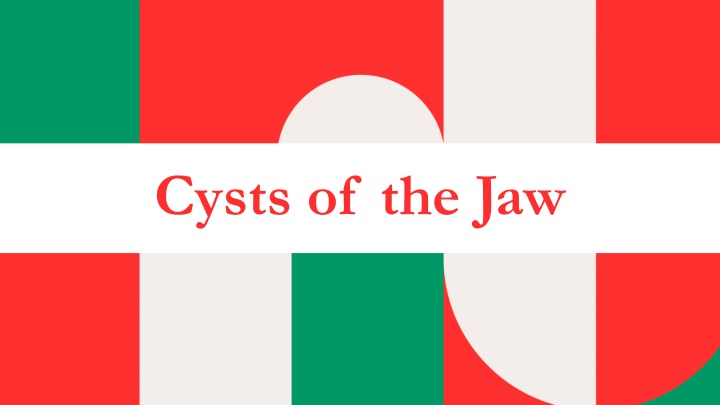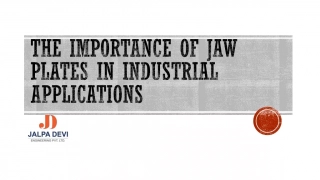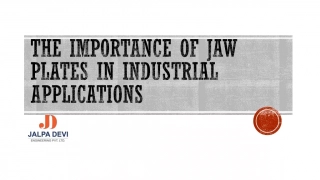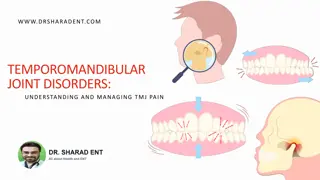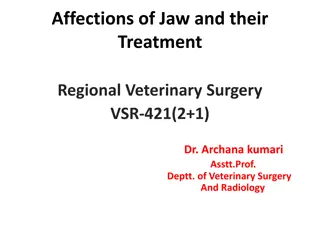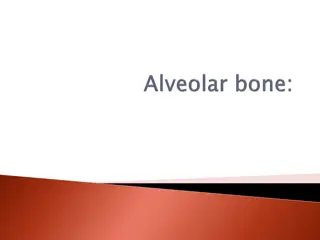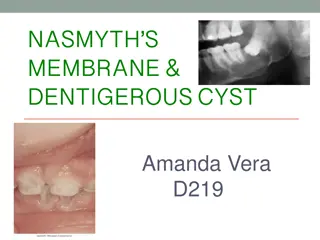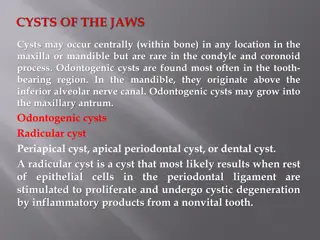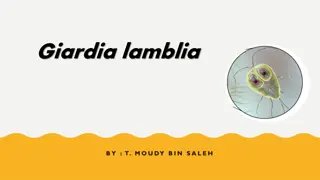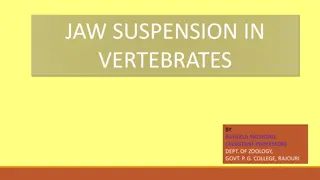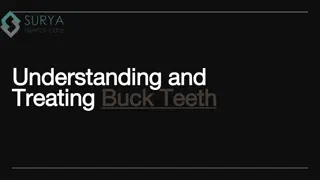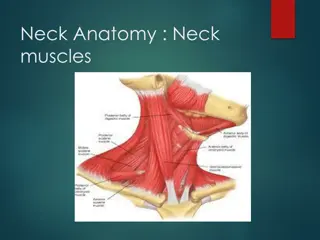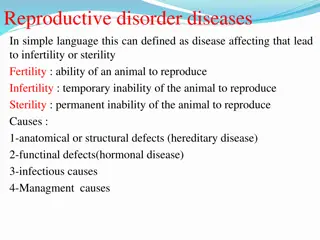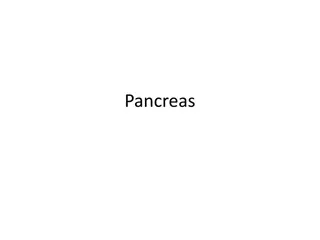Overview of Jaw Cysts: Classification and Clinical Features
A cyst in the jaw is a fluid-filled cavity lined by epithelium that commonly occurs in the jawbones. There are different types of jaw cysts, such as odontogenic cysts and non-odontogenic cysts, each with specific clinical features and radiographic appearances. Understanding the classification and features of jaw cysts is crucial for accurate diagnosis and treatment. This overview highlights inflammatory odontogenic cysts like radicular cysts and residual cysts, discussing their clinical and radiographic characteristics. It also touches upon developmental odontogenic cysts like dentigerous cysts.
Download Presentation

Please find below an Image/Link to download the presentation.
The content on the website is provided AS IS for your information and personal use only. It may not be sold, licensed, or shared on other websites without obtaining consent from the author.If you encounter any issues during the download, it is possible that the publisher has removed the file from their server.
You are allowed to download the files provided on this website for personal or commercial use, subject to the condition that they are used lawfully. All files are the property of their respective owners.
The content on the website is provided AS IS for your information and personal use only. It may not be sold, licensed, or shared on other websites without obtaining consent from the author.
E N D
Presentation Transcript
INTRODUCTION Cyst is defined as a pathologic cavity filled with fluid, and is lined by epithelium. It can also be defined as fluid- or semi-fluid-filled pathologic cavity lined by epithelium more often occurring in the jawbones than in any other bone. It is thought to arise from the rests of odontogenic epithelium remaining after tooth formation.
CYSTS CLASSIFICATION Odontogenic cysts(ODC) Inflammatory ODC Radicular (dental) cyst Residual radicular cyst Developmental ODC Dentigerous cyst Odontogenic Keratocyst (OKCs Lateral periodontal cyst Glandular odontogenic cyst Adenomatoid odontogenic cyst Non odontogenic cyst Nasopalatine duct/Incisive canal cyst Traumatic bone cyst
INFLAMMATORY ODC RADICULAR CYST Clinical Features Radicular cyst is commonly seen in second to fifth decades of life . Maxillary anterior region is most commonly affected as it is prone to more frequent trauma. It is seen at apex of non-vital teeth. It is asymptomatic unless it is secondarily infected. Large cyst results in the swelling of the jaw and mobility of adjacent teeth. Radiographic Features Radicular cyst appears as radiolucent area at the apex of tooth with well-demarcated sclerotic margins unless secondarily infected. The size of radiolucency is vary from small to large in diameter In case of secondary infection margin of cyst can be destroyed. Anatomical structures, such as maxillary antrum, nasal fossa and mandibular canal are frequently involved by teeth. Differential DiagnosisIt includes periapical granuloma (size of granuloma is less than 1.5cm), periapical scar (history), traumatic bone cyst (not associated with teeth) and periapical cemental dysplasia (tooth is vital )
RESIDUAL CYST Residual cysts most commonly are the retained periapical cysts from teeth that have been removed. They could also develop in a periapical granuloma that is possibly left after an extraction. 3 Clinical Features Residual cyst can be found in any of the tooth-bearing area of the maxilla or mandible. Size may range from a few millimeters to several centimeters. Clinically, these cysts are usually found on routine radiographic examination of patients. Usually they are painless unless secondarily infected. They do not show expansion of cortical plates. Radiographic Feature: There is well-defined unilocular radiolucency in the periapical area of extracted tooth. If the cyst is secondarily infected, the hyperostotic border may be absent. Cyst may displace mandibular canal and adjacent teeth. Differential Diagnosis Differential diagnosis includes keratocyst (mandibular posterior area), traumatic cyst (not associated with teeth) .
Developmental Odontogenic Cysts Radiographic Features DENTIGEROUS CYST Dentigerous cyst appears as well-defined radiolucency with Clinical Features Dentigerous cysts develop around the sclerotic borders seen at the cementoenamel (CE) junction of crown of an impacted or embedded unerupted or unerupted tooth. supernumerary tooth or in association with odontomas. The sclerotic border is absent in case of infected cyst. The teeth They are frequently associated with mandibular third molar followed by maxillary canines, maxillary third molar and are usually greatly displaced from their original position and mandibular second molar. are found lying on floor of cavity. Radiographically, dentigerous cyst can be central (cyst enclosing the crown of tooth symmetrically), lateral (cyst arising laterally from one side of crown) and circumferential (when whole tooth lies within the cystic cavity). Differential Diagnosis Differential diagnosis includes: adenomatoid odontogenic cyst (AOT; maxillary anterior region) Calcifying epithelial odontogenic tumour (evidence of calcification) Radicular cyst (carious teeth).
Odontogenic Keratocyst (OKCs ) Clinical Features OKCs can develop in association with an unerupted tooth or as solitaryentities in bone.OKCs usually cause no symptoms, although mild swelling may occur It is most commonly located in molar ramus area of the mandible Radiographic Features It has radiolucency radiographic appearance. Differential diagnosis includes: Radiographically, it appears as round or oval unilocular or radicular cyst (nonvital teeth) multilocular radiolucency; however, as compared to other dentigerous cyst (does not expand anteroposteriorly) cysts, it is less radiolucent due to the presence of keratin in residual cyst (history) it. The well-defined and sclerotic borders may be visible traumatic bone cyst (no expansion) around the radiolucency if the lesion is not infected 5
LATERAL PERIODONTAL CYST Clinical Features It is usually asymptomatic and often discovered during normal radiographic examination. It is usually seen in fifth or sixth decade of life with slight male predilection. Eighty percent of the cases are reported in mandibular premolar canine and lateral incisor areas. Radiographic Features As the name suggests this cyst appears as a radiolucent area situated laterally at middle third of the affected tooth between the apex and the alveolar crest of tooth. It is oval or round in shape with the size as small as less than 1 cm in diameter. The associated tooth is vital. The borders are sclerotic, well-defined surrounding the radiolucency, which is often missing in case of infected cyst. 6 Differential Diagnosis Differential diagnosis includes dentigerous cyst (associated with unerupted tooth), and radicular cyst (teeth are non-vital).
GLANDULAR ODONTOGENIC CYST Clinical Features It is relatively rare cystic lesion that occurs over a wide age range from the second to ninth decades, with a peak frequency in the sixth decade, more frequently in males than in females with a predilection for anterior mandible. The lesion shows slow, progressive, locally destructive, painless growth. Radiological Features The lesion appears as well-defined multilocular, occasionally unilocular radiolucency with sclerotic or scalloped borders. Root resorption of associated teeth and tooth displacement is noted. Differential Diagnosis All the lesions which are considered in the differential diagnosis of lateral periodontal cyst should be considered
ADENOMATOID ODONTOGENIC CYST Clinical Features Adenomatoid odontogenic cyst is most commonly seen in individuals between 10 and 40 years of age with female predilection. The most common site of occurrence in the jaw is the anterior portion of maxilla than in the mandibular region. It may produce obvious swelling clinically, which is usually asymptomatic. It is painless. Radiographic Features It appears commonly as a unilocular radiolucency with smooth corticated border. Sometimes, it may be having sclerotic border. Generally, it presents as radiolucency adjacent to or involving crown of associated tooth.Occasionally, area of multilocular radiolucency with scalloped border may be seen. Sometimes, radio-opaque foci may be Differential Diagnosis It includes identified within the radiolucent region. Adjacent tooth displacement and odontogenic keratocyst tumour (more in posterior region) divergence of associated root may be reported with slight erosion of calcifying odontogenic cyst (common in old age) underlying alveolar bone dentigerous cyst (posterior region).
No Odontogenic Cyst NASOPALATINE DUCT CYST Nasopalatine cyst is also called incisive canal cyst. Clinical Features Nasopalatine cyst is seen in fourth and fifth decades with male predilection. There is swelling in the anterior palate. Many lesions are asymptomatic and discovered only on routine radiographic examination. Radiographic Features It appears as an area of midline radiolucency situated between roots of upper central incisor in nasopalatine canal. It can be round, oval or irregular in shape with curved margin. If the superimposition of anterior nasal spine occurs, cyst appears as heart shaped. It can cause resorption of root and displacement of teeth. Differential Diagnosis It includes incisive fossa (radiolucency less than 6 mm), radicular cyst (pulp is non-vital) and median palatine cyst (radiolucent lesion is behind the incisive canal).
TRAUMATIC BONE CYST Clinical Features It is most frequently reported in older age group with male predominance.Mandible is affected more than maxilla in the jaws. It is seen in premolar molar area. It presents as painless swelling. . Teeth in the affected area are vital. Radiographic Features Area of radiolucency is situated in canine, bicuspid and molar regions of mandible. The radiolucent lesion is well demarcated from the adjacent bone. Margin is well defined or ill defined with thin radio- opaque border. In some cases, as lesion extends between roots, the border becomes irregular and scalloped. Differential Diagnosis It includes: radicular cyst, keratocyst (it expands along the bone).
